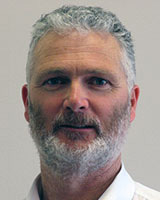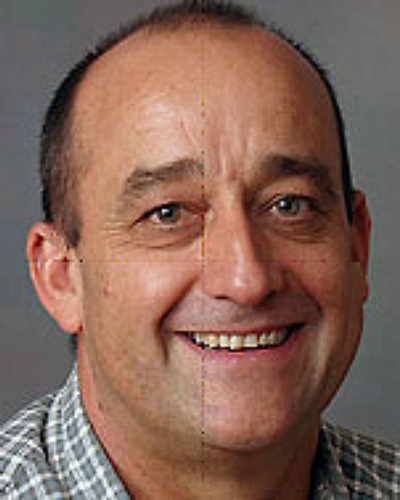Recruitment is a major challenge for rural and remote mental health services in many countries including Australia, Canada and the USA1-8. Factors underpinning the recruitment of mental health practitioners to rural and remote communities are multifaceted, complex and under-researched2,9-11. Health workforce research has primarily focused upon addressing rural medical workforce shortages12; scant attention has been paid to the allied health workforce13. The rural health workforce literature indicates that growing up and attending school in a rural setting, having a partner with a rural background, and completing extended rural clinical placements during pre-registration studies are the strongest predictors of rural practice when qualified14-17. These data suggest that a potential solution to the rural mental health shortage is for rural regions to 'grow their own' workforce. This notion pre-supposes the availability and viability of rurally based universities that are registered and licenced to provide pre-registration training to health professions that make up the mental health workforce.
The Gippsland Mental Health Vacation School is a novel recruitment strategy that seeks to encourage psychology, social work, occupational therapy and nursing students to consider commencing their careers in Gippsland, a rural region located in south-eastern Victoria18. The 5-day residential program includes information about the policy, funding and service guidelines within which behavioural health services operate, visits to services in the region and some social activities. Central to the vacation school approach is that tertiary training in the mental health professions such as psychology, occupational therapy and social work is not available in many rural areas. Gippsland typifies this problem. With a population of more than 250 000 people19, Gippsland has a university campus located in the region but accredited allied health practitioner training is not offered11. Potential trainees must enter locally available alternative courses of study, move away to study or undertake distance education to be trained in these professions. Very low numbers of allied health students undertake clinical placements in health services across the region20. Consequently, local mental health service providers are unable to draw upon a homegrown supply of professionals or student placements as workforce supply sources.
This mixed methods study examines the impact of the Gippsland Mental Health Vacation School on students' pre- and post-program levels of interest in both working and having a career in a rural setting, the mental health field and the rural mental health sector. The study was used to test the hypothesis developed during the initial pilot phase that the vacation school will increase students' interest in working in and a career in a rural setting, and working in and a career in the rural mental health sector. The study also tested the hypothesis that the program will not change students' interest in working in and a career in the mental health sector. In-depth semi-structured individual interviews explored whether the vacation school experience had changed participants' interest in and attitudes toward the three foci of the study outlined above. Analysis of the qualitative data was used to confirm or contradict, and add depth to, the results of the statistical analysis21.
This study utilised a sequential confirmatory mixed methods design, where quantitative and qualitative data were collected in sequence, analysed separately, and then merged21-23. The study included online surveys and semi-structured in-depth individual interviews.
Participants
Psychology, social work, occupational therapy and nursing students in either their third or fourth year of undergraduate or first- and second-year postgraduate qualifying courses and studying at a Melbourne-based university were invited via an email from their course coordinator to participate in the program. The email included a brochure promoting the vacation school program and a link to an online application form. All students who applied to initial pilots were accepted into the program; however, schools held in 2011, 2012 and 2013 were oversubscribed, therefore a selection process was instituted.
Eighty-one students participated in the five vacation schools held in the years 2010 to 2013. Of the entire cohort, 76 students (93.8%) completed the online pre-program questionnaire, 65 (80.2%) completed the post-program survey, and 60 (74.1%) students completed both pre- and post-program online surveys. The online survey response rate was above the 60.0% response rate considered 'very good' for email surveys24. The response rate was between the 'stringent' (88%) to 'liberal' (23%) response rates continuum for educational studies outlined by Nulty25.
Table 1 shows the demographic profile of participants. The majority of the matched pre- and post-matched sample was female. The median age of matched pre-post participants was 23.0 years and the mean age was 38.74 years (standard deviation (SD)=11.3 years; range 20-59 years). Over half of the matched pre-post student cohort was studying psychology, while almost a third were social work students. The majority of students were in their third or fourth year of undergraduate studies. Urban background students constitute over half of this cohort. Twelve students had undertaken a mental health clinical placement, seven participants had undertaken a rural placement and one student had undertaken a rural mental health placement prior to attending the vacation school.
Twenty-five students were interviewed over a 3-month period from September to the end of November 2013, 14 (56%) of whom had provided matched repeated data (reported above). The interview cohort included at least one representative from each of the five vacation school programs; however, 84% of the students interviewed had attended either the 2011, 2012 and 2013 programs.
As illustrated in Table 1, the demographic profiles suggest that the students interviewed did not differ greatly from those who provided the matched repeated measure data. Although the majority of students were female, the gender profile approximated that of the mental health workforce in Australia. Recent data indicate that females now form 76.7% of the psychology workforce26. The proportion of female social workers and occupational therapists working in the mental health sector is difficult to determine, but it is known that 81.2% of social workers are female and only 6.8% of occupational therapists are male27. A group that the vacation school cohort differs from is mental health nurses, a third of whom are male8.
Table 1: Demographic profile of participants
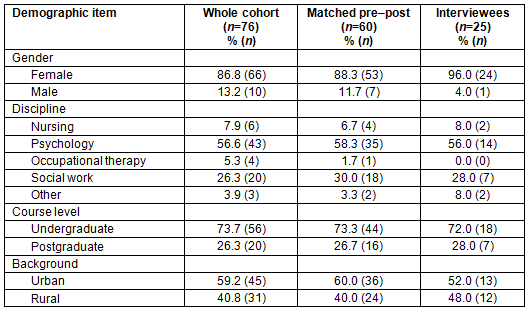
Quantitative component
Student participants were invited to complete online questionnaires prior to and immediately following the completion of each vacation school. Completion of the survey implied consent as the first section of the online survey included the explanatory statement. Participants were invited to rate their current level of interest in:
- working in a rural setting
- a career in a rural setting
- working in mental health
- a career in mental health
- working in rural mental health
- a career in rural mental health.
The term 'work' was used to convey the notion of employment by which one earns a living and that might be time limited28,29, while the term 'career' was used to convey the longer term course of an occupation or professional life30,31. Participants responded to the six statements on a Likert scale ranging from 1 (low interest) to 7 (high interest). Demographic data was collected in the pre-vacation school survey and included age, gender, residential background and schooling (urban or rural), and whether clinical placements had been undertaken in either a mental health and/or rural setting.
Paired sample t-tests were used to assess the impact of the program on students' interest scores described above. Problematic Shapiro-Wilk tests highlighted non-normality of the data, an underlying assumption for paired sample t-tests. Therefore a series of non-parametric analyses, Wilcoxon signed-rank tests32, were also conducted. There were minimal differences between parametric and non-parametric findings. Consequently, the former are reported here; however, caution should be used with interpretation. The formula used to calculate Cohen's d effect size was recommended by Allen33. A series of mixed between- and within-subject ANOVAs and one-way ANCOVAs were undertaken to investigate the possible interaction effect and impact of six fixed factors (vacation school group, gender, age group, background, course level and discipline). Statistical analysis was undertaken with the Statistical Package for the Social Sciences v20 (IBM; http://www.spss.com).
Qualitative component
From September to mid-December 2013, vacation school students from the five vacation school programs were invited to participate in semi-structured, in-depth interviews. Written consent was obtained from individual students prior to undertaking the interview. Telephone interviews were conducted by two researchers not involved with delivering the vacation school program. Interviews were recorded and transcribed. Although the interviews explored participants' overall personal experience of the vacation school program, this study specifically examines the impact, if any, the program had upon students' interest in and intent to pursue:
- rural work/career
- mental health work/career
- rural mental health work/career.
Following transcription, initial intra- and cross-interview analyses were undertaken using a conventional content analysis approach34. Initially undertaken independently by the first author and the principal interviewer, these analyses sought to break each transcript into units of meaning that preserved the integrity of participants' meaning and imposed as little interpretation as possible35. Validity of these initial analyses was subsequently checked through a series of meetings and discussion. This process identified participants' reflections and comments relating to the impact of the vacation school experience upon their attitudes, knowledge of and interest regarding the foci of this study outlined above. As this analysis was a mechanism to provide depth to and greater understanding to the quantitative approach outlined above23, all reflections and comments were afforded equal value whether or not they confirmed, contradicted or added depth to the quantitative findings.
Ethics approval
Ethics approval was provided by Monash University Human Ethics Committee (CF 10/1589 2010000876).
Quantitative findings
The series of mixed between- and within-subject ANOVAs and one-way ANCOVAs did not identify any significant influence on the findings from the potential confounders previously listed (see Table 2 for pre- and post-vacation school mean scores and Table 3 for one-way ANCOVA results for scale items).
Table 2 displays the mean and standard deviation scores from each time frame together with paired sample t-test statistics. As illustrated in Table 4, the general trend for all six items was for an increased mean score immediately after vacation school. There were significant mean score changes (Table 4) accompanied by a large effect size for level of interest in working in a rural setting, and moderate effect size changes for level of interest in a career in a rural setting, working in rural mental health, and a career in rural mental health.
The largest and significant change in scores were all associated with the rural variables, and least and non-significant change in interest in the two mental health items. The findings show stronger effect sizes for participants' interest in working and a career in a rural area as well as rural mental health work. Overall, the results indicate that the significant improvement in pre- to post-program scores for working and career in a rural area and rural mental health work are a consequence of participating in the vacation school program.
Table 2: Pre- and post-program survey scores for possible confounding variables
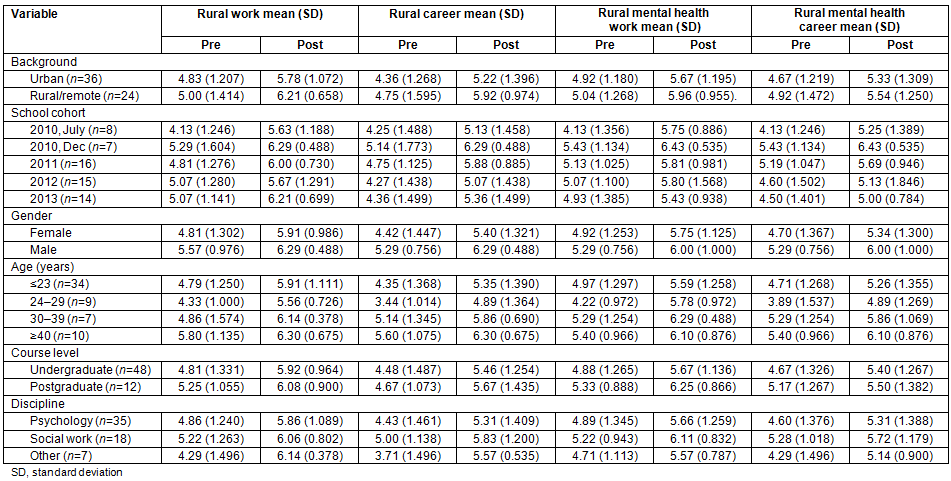
Table 3: One-way ANCOVA results for possible confounding variables?
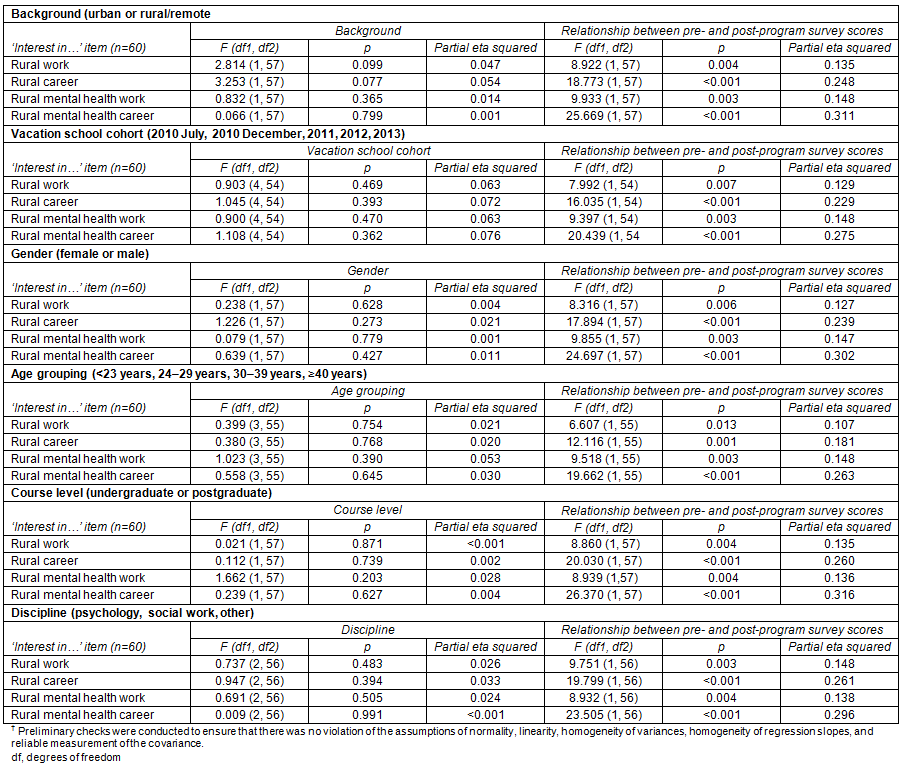
Table 4: Comparison of pre- and post-program survey scores

Interview results
The participants were invited to talk about their attitudes and interest in rural work and/or career, mental health work and/or career, and work and/or career in rural mental health prior to and following the vacation school program. The responses focused upon attitudes and perceptions toward living and working in a rural area and attitudes and interest in mental health work.
Interest in rural work: Students indicated that prior to the vacation school they held either a positive attitude to living and working in a rural setting or had not considered the issue. Those who expressed a pre-existing positive attitude were predominantly from a rural background:
I've been working rurally for, I don't know, a long time, possibly twenty years, maybe longer so the main thing is that I won't work in the city again. So that's totally bedded down for me. (Interview 21)
Those who had not considered the matter prior to the vacation school were mainly from urban backgrounds:
No, I hadn't considered it before that. I suppose because I've grown up in an urban setting. (Interview 11)
For some the vacation school experience resulted in a more positive view of rural life and/or an increased understanding of rural work/career options:
... it did show me that rural could be an option, which I would have never considered before going to the summer school. ... it opened my eyes to the potential that going rural could offer. (Interview 15)
Other students, particularly those from rural backgrounds, did not think that the vacation school experience had altered their attitude to living and working in a rural setting:
Didn't really change it - yeah I don't think it changed it. I guess it confirmed my thought that, there'd probably be quite a few positives of working in a rural area. (Interview 7)
In general, participating in the vacation school confirmed pre-program attitudes to rural work and life for those with a rural background, while for some students with an urban background the experience appeared to kindle interest.
Interest in mental health work: As an explanation for the modest effect size regarding mental health work, many students clearly articulated having a positive attitude to mental health prior to the vacation school. Such interest had stemmed from the influence of family or friends:
Pretty open, I've been doing volunteering with [a crisis support phone help line] in Melbourne for about, I think 6 years. So I'd always had a pretty open interest and I recognised - I mean most families - you come across people who've got mental health issues, and my brother's got a mental health issue, so I was very open to it. (Interview 16)
For others, an interest in the wellbeing of the Aboriginal community was the catalyst:
I was interested, that's why I put in for the school, and always will be. I'm particularly interested in Aboriginal health, or indigenous health, but I'll say Aboriginal because I'm an Aboriginal descendant but yeah, I believe that there's a dire need for improved outcomes and there's very little services to accommodate mental health in particular. And also because of comorbidity that often interferes with the ability of many services to get the right treatment or assistance for individual, and that interests me as well. And especially in relation to drug and alcohol with Aboriginal people, and I know it's not just Aboriginal people but that's my focus. (Interview 23)
Some students indicated that they found mental health intimidating:
I think my attitude towards working in mental health was that it was a bit scary; that the term mental health was like sort of worst of the worst I suppose in many ways. ... I wasn't particularly sold on the idea of 'yes I'm going to work in mental health that really rocks my boat'. It was just all a bit scary and daunting I guess - a bit unpredictable. (Interview 25)
Some students reported that prior to the vacation school they had a limited understanding of mental health:
It was probably more unknown than anything else. Yeah it was probably more unknown so it was grey.... my lack of experience within it. (Interview17)
Others had come to the vacation school with pre-conceived and generally negative ideas regarding mental health work:
Probably a fairly decent high burnout rate. ... A lot of negativity I'd heard and a lot of disrespect towards clients. (Interview 6)
Some participants were motivated by a desire to make a difference for others and considered working in mental health as a pathway to achieving this aim:
I think there's a lot more that can be done for those suffering from mental health. And I'm really interested in research as well and I want to be able to contribute to society and help develop policies and procedures and support for those suffering from mental illnesses. (Interview 2)
Students reported that the vacation school experience had affected their attitudes to mental health work in a range of ways. Many students reported feeling enthused about working in the field:
It reignited my passion to want to work in the mental health area. (Interview 6)
For some the experience improved their knowledge and understanding of the mental health sector:
... it just, it made me think about it more, definitely. It made me think that it would be, I don't know because I hadn't had much experience in it already, so it was more just like, it just made me open my eyes more to the possibilities of it. (Interview 18)
Other students left the vacation school with a sense that they were capable of working in the mental health sector:
I suppose going to the school gave me a sense that 'Yes, I can do this' and there's plenty of people out there that will help me to achieve it ... just the sense of being given some confidence about going into the field. (Interview 21)
Participating in the vacation school had motivated some students to organise mental health placements:
I tried to get a placement in - my final placement in an acute inpatient clinic. (Interview 6)
A number of students indicated that the vacation school had not influenced or changed their attitude to mental health work:
I don't think it changed it too much, I think my level of interest was more or less the same. (Interview 13)
One student left the vacation school with a sense that mental health workers try to support each other, which made it an attractive field to work in:
But it also gave me a bit of a better understanding of how interconnected all of them really are. I mean some of them have very specific roles and specific jobs, but they're very much supporting each other, in the rural area anyway they're very much supporting each other of what they do, so that was good. (Interview 20)
Others were left with a clearer understanding of work and career options in the mental health sector:
... knowledge of job opportunities in Mental Health - just in general in Mental Health, not just in a rural setting, but I suppose a lot of those jobs are also in a urban setting. (Interview 11)
For another student the experience helped them understand that some areas of mental health work might suit them better than others:
... I'm still just as interested in mental health, but it's given me more insight into the different areas and some, I think, no I don't think I'd like that kind of work, but then others I think, yep I could see myself doing that, so, actually getting to be there means I can picture it better. (Interview 14)
Generally, the vacation school experience re-affirmed most students' pre-program interest and commitment to working in mental health. For some students the vacation school increased their knowledge and understanding of the mental health sector, the range of employment opportunities and types of role and settings that might suit them. A small number of students reported that the vacation school program enabled them to appreciate that they were capable of working in the mental health field, while others were left feeling daunted by the prospect of mental health work.
Overall, the findings from the interviews support the quantitative results and suggest that the vacation school impacted on participants' interest in working and living in a rural area. Despite the interview data indicating that students from rural backgrounds on the whole did not think that the experience had altered their interest and attitudes much, the results of the one-way ANCOVA suggest these perceptions were not reflected in the lack of significant differences in pre- and post-program survey scores for rural background students in respect to interest in rural work and career in a rural location compared with students from an urban background. Participating in the program appears to have helped students better understand their work and career options in Gippsland and shaped a more positive attitude to working in a rural area. Despite the vacation school not affecting interest in mental health work, the qualitative findings indicate that the experience improved participants' knowledge and understanding of the mental health sector, addressed prior preconceptions and fears of working in the field.
Discussion
The findings highlight that a brief (5-day) program can change students' interest in working and living in a rural area, particularly the significant increase in pre- to post-program interest in relation to all of the rural and rural mental health variables. This was illustrated by a strong effect size for interest in rural work, and medium effect size for career in a rural setting, interest in rural mental health work and a career in rural mental health. This is consistent with the previous findings of the initial pilot study18.
The quantitative results were complemented by the interviews, in which students reported positive changes to their attitudes to both rural and mental health work. Students spoke of leaving the vacation school with a better understanding of both living and working in a rural area, and the potential work and career opportunities available in Gippsland. For some urban background students this was the first occasion that they had considered the idea of living and working in a rural area. Other students reported that the experience had prompted them to undertake a mental health clinical placement. While many students spoke of feeling enthused about working in mental health, others indicated that they left feeling daunted at the prospect of working in the mental health sector.
There was no significant change in mental health work (excluding rural) interest pre- to post-program. It should be noted, however, that the interest scores were very high (ranging from just below to a little above six on a seven-point scale) at both time frames, indicating a strong interest to work in the mental health profession generally. There was perhaps a 'ceiling effect' with these data, as the high scores prior to the school allowed little room for change (increase). This suggests, unsurprisingly, that the program attracts students who are already interested in and wish to pursue a career in the mental health field. This conclusion is supported by the interview data. Students commonly reported that an interest in mental health had been the primary reason to undertake pre-registration studies. Interestingly, the interview findings show that the vacation school program improved some students' knowledge, understanding and appreciation of work and career opportunities in the mental health sector.
The findings are important from two perspectives. First, they imply that short-term rural recruitment strategies affect attitudes towards and interest in pursuing a rural career in mental health. This complements the findings of Wright and colleagues36 that a 3-week rural health module increased medical students' knowledge and understanding of rural practice. The findings of Jones and colleagues37 suggest that this type of program should be undertaken in the final year of a professional's tertiary training, possibly in the 6 months prior to completion. Intervening during this period would highlight the attractions of rural living and rural employment opportunities, just as students start to contemplate their post-registration work options.
Second, the data indicate that a brief intervention designed to attract students to rural mental health work changed participants' knowledge and understanding of future work and career opportunities in the sector. Even though the program appears to have attracted students with a pre-existing interest in mental health work, the vacation school experience resulted in significant change in pre- to post-program scores for interest in work and career in the rural mental health sector. The interview data did not specifically expand upon these quantitative findings. Students reported, however, that the experience had increased their knowledge and understanding of work and career opportunities in the mental health field generally.
Limitations
While a matched sample of 60 participants over two time periods is statistically adequate for reporting of data, the sample is still relatively small. However, it was thought pertinent to have the findings in the public domain earlier rather than later. Other limitations include that the study did not have a specific theoretical basis, the data represents interest and not actual behavior, and that it is unclear whether the immediate positive changes in interest are maintained in the longer term. The 'proof of the pudding' will be when a significant number of vacation school participants are employed in the Gippsland area. Finally, the findings may not be generalisable to other locations and settings as the research was undertaken in a specific rural area and it is unclear how representative the vacation school participants are of the overall allied health and nursing student population in attitudes and interest in rural work, mental health work and rural mental health work.
The findings of this study are important as they highlight the impact that a short-term recruitment intervention can have on both rural and urban student interest in rural mental health work. The study also highlights the need for further research into the longer term impact of brief recruitment interventions, such as the vacation school, in relation to whether the immediate positive impacts are maintained over time, and whether the initiative results in increased recruitment of mental health practitioners to rural areas.
Acknowledgements
This study would not have been possible without the financial support provided by the Australian Government Department of Health and the Victorian Government to pilot the initiative. The ongoing success of the program would not be possible without the active support and involvement of a broad range of mental health, alcohol and drug, generalist counselling and specialist counselling services from across the Gippsland region.
References
1. Thomas D, Macdowell M, Glasser M. Rural mental health workforce needs assessment - a national survey. Rural and Remote Health 12: 2176. (Online) 2012. Available: www.rrh.org.au (Accessed 17 December 2014).
2. Moore T, Sutton K, Maybery D. Rural mental health workforce difficulties: a management perspective. Rural and Remote Health 10(3): 1519. (Online) 2010. Available: www.rrh.org.au (Accessed 3 September 2014).
3. Aisbett DL, Boyd CP, Francis KJ, Newnham K, Newnham K. Understanding barriers to mental health service utilization for adolescents in rural Australia. Rural and Remote Health 7(1): 624. (Online) 2007. Available: www.rrh.org.au (Accessed 5 August 2014).
4. Spero JC, Fraher EP. Running the numbers: the maldistribution of health care providers in rural and underserved areas in North Carolina. North Carolina Medical Journal 2014; 75(1): 74-79.
5. Hough RL, Willging CE, Altschul D, Adelsheim S. Workforce capacity for reducing rural disparities in public mental health services for adults with severe mental illness. Journal of Rural Mental Health 2011; 35(2): 35-45.
6. Ellis AR, Konrad TR, Thomas KC, Morrissey JP. County-level estimates of mental health professional supply in the United States. Psychiatric Services 2009; 60(10): 1315-1322.
7. OECD. Making mental health count: the social and economic costs of negleting mental health. Paris: OECD Publishing, 2014.
8. Australian Institute of Health and Welfare. Mental health workforce 2014. (Online) 2014. Available: http://mhsa.aihw.gov.au/resources/workforce/ (Accessed 30 April 2015).
9. Perkins D, Larsen K, Lyle D, Burns P. Securing and retaining a mental health workforce in Far Western New South Wales. Australian Journal of Rural Health 2007; 15(2): 94-98.
10. Conomos AM, Griffin B, Baunin N. Attracting psychologists to practice in rural Australia: the role of work values and perceptions of the rural work environment. Australian Journal of Rural Health 2013; 21(2): 105-111.
11. Maybery D, Sutton K, Moore T. Training and recruiting psychologists for regional, rural and remote Australia. InPsych 2010; 32(5): 24-25.
12. Sutton K, Maybery D, Moore T. Creating a sustainable and effective mental health workforce for Gippsland, Victoria: solutions and directions for strategic planning. Rural and Remote Health 11(1): 1585. (Online) 2011. Available: www.rrh.org.au (Accessed 3 September 2014).
13. Dolea C, Stormont L, Braichet JM. Evaluated strategies to increase attraction and retention of health workers in remote and rural areas. Bulletin of the World Health Organization 2010; 88(5): 379-385.
14. McGrail MR, Humphreys JS, Joyce CM. Nature of association between rural background and practice location: a comparison of general practitioners and specialists. BMC Health Services Research 2011; 11: 63.
15. Walker JH, Dewitt DE, Pallant JF, Cunningham CE. Rural origin plus a rural clinical school placement is a significant predictor of medical students' intentions to practice rurally: a multi-university study. Rural and Remote Health 2012; 12: 1908. (Online) 2012. Available: www.rrh.org.au (Accessed 5 August 2014).
16. Rabinowitz HK, Diamond MJJ, Markham FW, Santana AJ. Retention of rural family physicians after 20-25 years: outcomes of a comprehensive medical school rural program. Journal of the American Board of Family Medicine 2013; 26(1): 24-27.
17. Stagg P, Greenhill J, Worley PS. A new model to understand the career choice and practice location decisions of medical graduates. Rural and Remote Health 9: 1245. (Online) 2009. Available: www.rrh.org.au (Accessed 5 August 2014).
18. Sutton K, Maybery D, Moore T. Bringing them home: a Gippsland mental health workforce recruitment strategy. Australian Health Review 2012; 36(1): 79-82.
19. Australian Bureau of Statistics. File generated 30 January 2014 using 2011 Census of Population and Households, LGA by SEXP, TableBuilder. Findings based on use of ABS TableBuilder data.
20. State Government of Victoria. The Gippsland Clinical Placement Network Profile report. Melbourne: State Government of Victoria, 2012.
21. Greene JC, Caracelli VJ. Defining and describing the paradigm issue in mixed-method evaluation. New Directions for Evaluation 1997; 1997(74): 5-17.
22. Palinkas LA, Horwitz SM, Chamberlain P, Hurlburt MS, Landsverk J. Mixed-methods designs in mental health services research: a review. Psychiatric Services 2011; 62(3): 255-263.
23. Creswell J, VL Plano Clark. Designing and conducting mixed methods research. 2nd ed. Los Angeles: Sage Publications, 2011.
24. University of Texas at Austin. Instructional assessment resources: assess teaching - response rates. (Online) 2011. Available: http://www.utexas.edu/academic/ctl/assessment/iar/teaching/gather/method/survey-Response.php (Accessed 3 September 2014).
25. Nulty DD. The adequacy of response rates to online and paper surveys: what can be done? Assessment & Evaluation in Higher Education 2008; 33(3): 301-314.
26. Australian Institute of Health and Welfare. Allied health workforce 2012. National health workforce series 5. Canberra: AIHW, 2013; 231.
27. Australian Health Workforce Advisory Committee. The Australian allied health workforce - an overview of workforce planning issues. AHWAC report 2006.1. Sydney: AHWA, 2004.
28. Oxford English Dictionary. 'work, n'. (Online) 2014. Available: http://www.oed.com/view/Entry/230216?rskey=2EqbOc&result=1#eid (Accessed 30 May 2015).
29. Macquarie Dictionary. 'work' (entry 6). (Online) 2015. Available: https://www.macquariedictionary.com.au/features/word/search/?word=work&search_word_type=Dictionary (Accessed 30 May 2015).
30. Macquarie Dictionary. 'career' (entry 2). (Online) 2015. Available: https://www.macquariedictionary.com.au/features/word/search/?word=career&search_word_type=Dictionary (Accessed 30 May 2015).
31. Oxford English Dictionary. 'career, n'. (Online) 2014. Available: http://www.oed.com/view/Entry/27911?rskey=r8MQy3&result=1&isAdvanced=false#eid (Accessed 30 May 2015).
32. Pallant J. SPSS survival manual: a step by step guide to data analysis using SPSS. Crows Nest, NSW: Allen & Unwin, 2011.
33. Allen P, Bennett K. SPSS for the health & behavioural sciences. Melbourne: Thomson, 2008.
34. Hsieh H-F, Shannon SE. Three approaches to qualitative content analysis. Qualitative Health Research 2005; 15(9): 1277.
35. Marshall C, Rossman GB. Designing qualitative research. Los Angeles: Sage Publishing, 2011.
36. Wright JR, Bourke L, Waite CJ, Holden TA, Goodwin JM, Marmo AL, et al. A short-term rural placement can change metropolitan medical students' knowledge of, and attitudes to, rural practice. Medical Journal of Australia 2014; 201(2): 103-105.
37. Jones M, Bushnell J, Humphreys J. Are rural placements positively associated with rural intentions in medical graduates? Medical Education 2014; 48(4): 405-416.
